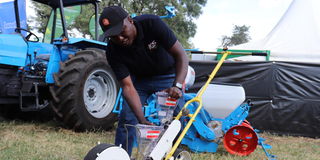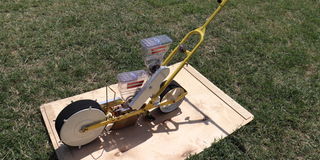A new innovation revolutionizing planting for Nakuru farmers

Alvanus Gichana showing the small planter at the Nakuru ASK show.
It's common to accidentally scatter too many seeds in one spot- especially for small seeds- whether you're broadcasting them or trying to plant them individually on a seedbed.
This often leads to overcrowding, forcing you to thin out the seedlings later - a process known as gapping.
Even after all this, when the seedlings have germinated, transplanting happens which is time-consuming and stressful for the young plants, sometimes causing transplant shock.
Planting is an important step in growing crops successfully as it sets the stage for the entire growing season and can make a significant difference in a farmer's success.
To adhere to good planting practices, farmers need to focus on planting the right number of seeds, distributing them evenly across the field, and timing the planting correctly for optimal growing conditions.
The use of a manually pushed small planter can help farmers achieve this.

The small planter is mostly used to plant small seeds.
Used to plant small seeds like onions, cabbages, and coriander among others, the small planter can open, and close furrows and lightly compress the seed with its wheel made of a soft-like sponge to allow them get the right conditions for germination.
Alvanus Gichana of ICS Agri Kenya notes that small scale farmers are usually stuck using the manual and traditional means of planting and transplanting, which wastes a lot of resources.
“The small planter aims to eliminate this by doing direct planting and saves the plant a whole lot of stress when being transplanted,” he says.
The planter, which has two hoppers, allows one to carry seed and the other fertilizer, which all get launched into the soil at one go.
Over and above this, the machine can be calibrated by the farmer to give an exact spacing of the seeds which allows for precision and an adequate plant population.
“Normally a farmer will use an approximation which most of the time is not accurate and in return will not give you precision in spacing. The small planter is calibrated by the farmer to fit the exact spacing for an optimum plant population and nutrient use,” says Gichana.
“Manual planting, especially broadcasting seeds on seedbeds or fields, frequently results in wasted seeds and fertilizer while the planter allows for efficient use of seeds and fertilizer. This helps save time and other resources and most importantly is labour efficient,” he adds.
While the planter majorly caters to small seeds, this can be adjusted by changing the seed plate if one wanted to plant larger seeds.


